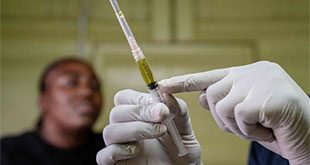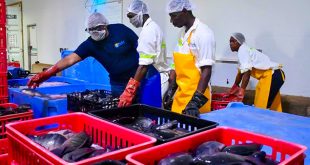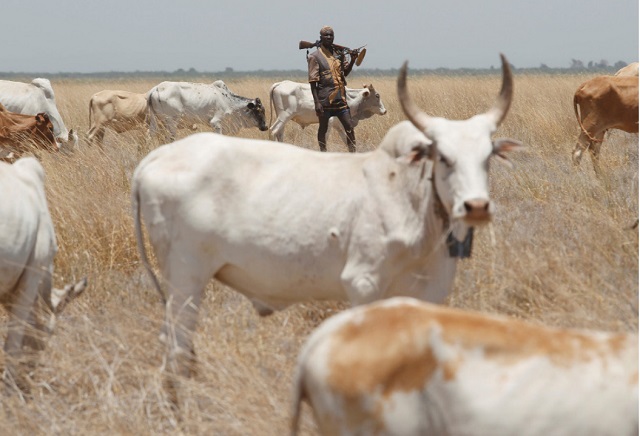
Does sub-region require military response only?
Kampala, Uganda | RONALD MUSOKE | Until March 23 when Lt. Gen. Muhoozi Kainerugaba, the Commander of Land Forces, warned Karimojong cattle rustlers of hellish consequences, the pandemonium seen in the region over the last two years had gone under the radar.
Government officials including President Yoweri Museveni had repeatedly told Ugandans that the clashes between the military and Karimojong warriors were under control. But, the tone changed after March 21 when three government geologists and two soldiers were attacked and killed by suspected Turkana cattle rustlers in Moroto District.
The geologists attached to the Ministry of Energy and Mineral Development were; Richard Kiggwe, the lead geologist and his colleagues, Charles Olweny and Edna Musiime, an intern from Makerere University. The trio was apparently picking soil samples from Lokiselei sub-county in Moroto District accompanied by two UPDF soldiers. They all died under a hell of gunfire. The loss of the soldiers particularly angered Muhoozi as he tweeted furiously days later.
“My Karimojong brothers! We have begged you to stop the life of robbery and violence. We have begged you to stop attacking your neighbours but to no avail! You have refused all our appeals! Well, now we are coming and hell is coming with us!” Muhoozi said via his twitter handle.
“Karimojong criminals killed my soldiers in cold blood! There will be hell to pay for that!” If they want to avoid retribution they better get in touch with our RDCs [Resident District Commissioners] and commanders in the region. Now!! Otherwise, let us see who the real men are!”
And just like Muhoozi promised, hell has since engulfed pockets of Karamoja as the UPDF upped the ante in searching for and disarming the Karimojong warriors. In one of the videos that have circulated from the battlefield, soldiers recorded and shared an incident in which they watched over and taunted a charred body of a suspected Karimojong warrior in a smoldering hut.
But it is the fleeing civilians that have left Ugandans wondering what exactly is happening in northeastern Uganda. Thousands of civilians have had to flee the conflict and have taken refuge in the neighbouring districts.
Last month, television footage showed files of civilians fleeing the neighbouring district of Kapelebyong heading towards safer areas within Teso. Women with luggage on their heads and babies strapped on backs along with young children moved on foot, bicycles and bodabodas from Napak towards Teso. Those interviewed said their homes had become insecure because of constant attacks from the Karimojong cattle rustlers.
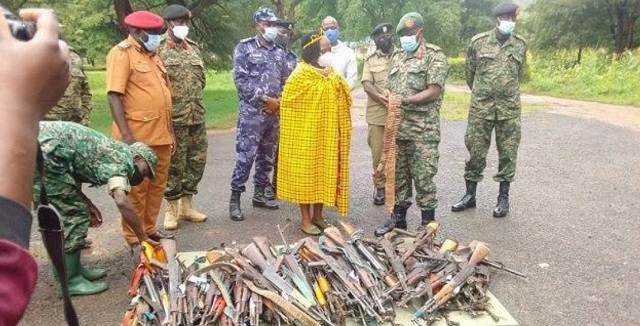
Situation under control
Interestingly, the military quickly came out to refute claims of the situation getting out of control. In a statement published on March 29 on “The situation in Karamoja,” Brig. Gen. Felix Kulayigye, the UPDF Spokesperson said the security situation in Karamoja “had not deteriorated.”
Kulayigye instead reeled off several achievements of Operation Usalama kwa Wote (Peace for All) which was launched in July 2021 to restore peace in Karamoja, a sub-region which is as big as Rwanda.
Kulayigye said, a lot has been achieved and the joint UPDF and Uganda Police forces deployed in the area are working tirelessly to maintain peace and security in the area.
He said in the period of March 19-29, close to 20 warriors had been killed, four guns recovered while 47 rounds of ammunition had been recovered and 39 warriors arrested. About 780 livestock had also been recovered. The UPDF lost four soldiers while five civilians were also killed by suspected Karimojong warriors during the month.
Kulayigye then stretched UPDF’s achievements to the last nine months up to July, last year. He said the UPDF had killed 309 Karimojong warriors, recovered 184 rifles and 2,352 rounds of ammunition. Close to 1800 Karimojong warriors had been arrested, 360 of whom had been prosecuted in the courts of law. Kulayigye said 17,000 livestock had also been recovered during the same period.
“The UPDF working with other sister security agencies, the local leaders and all the peace-loving Wananchi (citizens) in Karamoja will continue working together to completely pacify Karamoja and end all the criminality in the sub-region and the neighbouring communities,” he said.
Trivializing Karamoja conflict
But MPs from Karamoja immediately came out to rebut Kulayigye’s all-is-well statement.They said the Karimojong are angered by statements from the UPDF who claim the situation is under control.
The MPs and civil society say cattle thefts are spiraling out of control in the sub-region. The legislators called out Kulayigye saying the UPDF always wants to paint a picture of success in Karamoja.
The MPs said Karamoja has been suffering since the government pulled UPDF personnel from the region and took them to Somalia. They said a vacuum was created that the cattle entrepreneurs exploded and people began re-armament.
As a result, some say the violence has got back to the pre-disarmament days, the ten year government programme that began around 2001 and ended in 2010. The disarmament programme saw the UPDF rid Karamoja of over 40,000 illegal arms, bringing an end to armed cattle rustling.
The MPs accuse the army of commercializing cattle rustling in Karamoja, saying the UPDF which is supposed to secure the lives and property of the Karimojong have become perpetrators of the crisis.
Remigio Achia, the NRM MP for Pian County in Nabilatuk District, one of the nine districts that comprise Karamoja accused the UPDF of criminalising the whole of Karamoja.
Achia who also doubles as the Chairperson of the Karamoja Parliamentary Caucus said the kind of attitude showed by the military has led to loss of over 3,000 law-abiding people while thousands of children have been sent into destitution and are now roaming the streets of towns of Soroti, Mbale, Iganga, Jinja and Kampala.
“We members of Karamoja condemn in the strongest terms the criminality that has been allowed to thrive in Karamoja since 2019 and they still continue to call it ‘isolated incidents.’”
“We call out the reckless statements by Uganda People’s Defence Forces Spokesperson, Felix Kulayigye, by referring to the situation in Karamoja and neighbouring districts as being under control yet the statements are far from reality,” he said.
The MPs added that whereas there are claims by the security forces that they have recovered over 17,700 head of cattle, the livestock has never been handed back to the owners, and most of the animals recovered from the raids have disappeared under the watch of the UPDF.
The grim situation in Karamoja has sucked in leaders of the sub-regions that neighbour Karamoja. In the neighbouring sub-region of Teso, one MP accused UPDF commanders of “superintending over people’s security in the region to extort money from residents whose livestock has been raided.”
Patrick Okabe (Serere County) who heads the Teso Parliamentary Group said: “Cows are stolen at 8pm but the rule is that we can’t follow them at 8pm, we shall follow them the following morning when the man has moved several kilometres away. After breakfast is when they (soldiers) will follow up and you’re supposed to facilitate.”
“A poor Ugandan who has lost cows is asked to give money and facilitate the army to follow up the cows. This is a very painful experience. So we demand that the complacent commanders helping pacify Karamoja be removed from there because they have failed in their role.”
In a recent meeting with leaders from Teso, Karamoja and Sebei, Prof. Francis Omaswa, an elder from Teso said the government needs to respond to the local people’s needs.
“Let us feel their pain, don’t trivialize their issues. You cannot say the situation is under control. How can the situation be under control when there are so many internally displaced Ugandans?”
Mike Mukula, the NRM Vice Chairman Eastern Region and convener of the meeting, noted that although matters of national security are a function of the central government, clarity of mind in providing leadership to the people who had got these challenges on the ground is important.
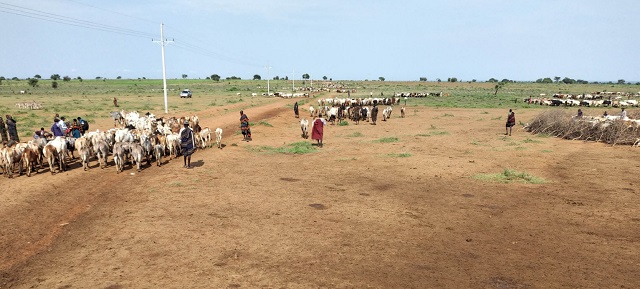
‘Rogue UPDF elements’
On April 10, Brig. Joseph Balikuddembe, the 3rd Division Commander confirmed to local broadcaster, NTV that, in fact, there are ‘rogue UPDF elements’ who have been conniving with Karimojong criminals to steal cattle from Karimojong homesteads.
“We don’t deny that among our own, we have some errant soldiers who normally connive with the criminals in the community and steal the cows that are already impounded but we have been arresting them.”
But, Balikuddembe insists the situation is not as volatile as is portrayed in the media. He said everything is under control. The only challenge, Balikuddembe said, is that Karimojong criminals who in the past had surrendered their guns voluntarily have since got new ones and returned to cattle rustling. He also mentions the alliances among the Karimojong clans being the other challenge in stemming the vice.
“The alliance of the Turkana (from Kenya) and Matheniko (Uganda) has been a real challenge because they keep supplying guns to the Karimojong allies.”
Still, Balikuddembe reiterated how peace will soon return to the whole of Karamoja. He said the UPDF is working on bolstering the number of soldiers in the sub-region by sending two additional brigades to Karamoja.
“We shall ensure the issue of insecurity in Karamoja is never talked about in the media,” he told NTV, “We shall cover every inch of the region to ensure that the source of guns (Turkana) ceases and that those who possess guns in Karamoja are dealt with firmly.”
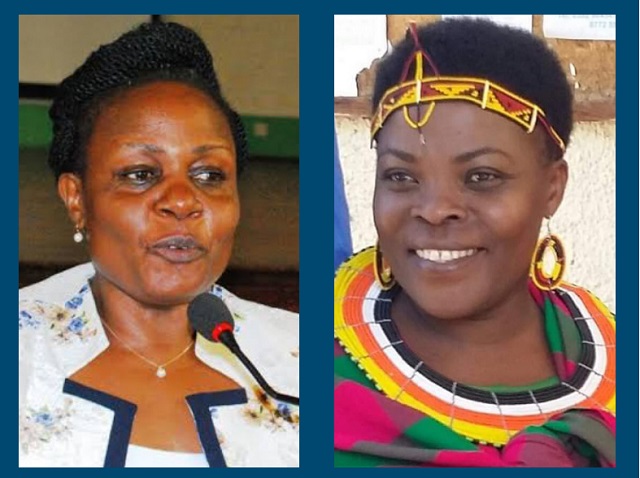
But will it happen?
Karamoja, a conglomeration of nine districts, is 27,511 sq km in size and has a population of slightly over a million people. Until recently, it was one of the remotest sub-regions in Uganda and because of this; it is still plagued by some of the lowest development indicators in the country.
The region suffers from perennial drought rates of about 65%; a rate which is three times higher than the national average. Historical drought analysis done by two UN agencies, the Food and Agriculture Organization (FAO) and the World Food Programme (WFP) shows that Karamoja has a 30% chance of experiencing a drought or dry spell in any given year, which again is the highest in the country.
And, although the Karimojong have been trying to transition from pastoralism to settled agriculture for many years now, many are easily frustrated by the harsh climate.
Many, especially the youth, who are just as ambitious as other young Ugandans, have tended to resort to the age-old practice of their forefathers: cattle rustling. It is an ancient traditional practice in the region, used in the past to acquire cattle for prestige and paying off bride price.
But in recent years, the practice has turned into a commercial venture involving businessmen from outside Karamoja. Civil society agencies have in the recent past told The Independent how communities in Moroto, Napak and Kotido have lost thousands of cattle and human life.
Recent research by the Pretoria-based Institute for Security Studies on cattle raiding in East Africa also shows how a growing demand for cattle across eastern Africa has exacerbated the problem.
The paper, “Vanishing herds: Cattle rustling in East Africa and the Horn,” was published in December 2019 based on research from 2017 and the first half of 2018. It recorded brutal attacks in which thousands of livestock and dozens of people were killed in various parts of eastern Africa.
The researchers said most incidents suggest that the practice has become a complex transnational organised crime because of the use of small arms and light weapons and the involvement of actors whose interests are purely economic.
Multiple factors such as the role of local politicians, the involvement of businessmen supplying meat to towns and cities as well as unemployment; especially among the youth, are some of the elements that have modified the traditional face of cattle rustling.
The researchers say the practice is now embedded in the wider cattle trade business enabled by government corruption, with state officials often turning a blind eye or collaborating with criminals.
The animals are now being moved across international borders in small numbers to avoid suspicion. In some instances, the cattle are disguised to conceal their real colours. In other circumstances, documents are falsified to show that cattle have followed a genuine transaction process necessary for export.
In his 2003 paper, “The Karamoja Conflict: Origins, Impact and Solutions,” Michael Ochieng Odhiambo says one of the challenges of solving the “Karamoja problem” is the different prisms with which both the Karimojong and non-Karimojong people view the same issue.
“For a Karimojong, the basic problem of Karamoja revolves around poverty, underdevelopment and livelihood insecurity (while) for the non-Karimojong, whether within or outside Karamoja, the basic problem behind the conflict and insecurity is culture,” Odhiambo noted in his paper.
Odhiambo says the Karimojong are obsessed with the cow as the definition of wealth and status. This is what, for generations, has been encouraging the cattle raids, thus feeding the conflict and insecurity in the region. But, Odhiambo said, the cattle complex has other dimensions, like the high bride price and the warrior phenomenon.
“A Karimojong may pay as many as 100 head of cattle for a bride; while the warrior complex within the region feeds on bravery which is demonstrated by the number of cattle a young man has raided from the enemy and even the number of enemies he has killed.”
In another paper published in 1998 in the Cultural Survival Quarterly Magazine, Frank E. Muhereza noted that, since the colonial period, different Ugandan governments have tried to adopt anti-pastoralist policies, leading pastoralists to lose land vital for the survival of the herds on which they depend.
In the paper titled, “Violence and the State in Karamoja: Causes of Conflict, Initiative for Peace,” Muhereza says all attempts to forcefully settle pastoralists have resulted in an unanticipated social crisis, setting the stage for an emerging conflict over the allocation and use of resources.
Other researchers say since the British colonial times, the Karimojong have always laid blame on the government for ignoring their problems, and for doing nothing to address their plight and provide an environment that would encourage other income generating and livelihood enhancing activities.
As a result, there have been no alternative means of survival, apart from cattle keeping and cattle raids. They argue that only through the creation of alternative opportunities would the cattle raids and general insecurity in Karamoja end.
The isolation and marginalisation of Karamoja dates back to the colonial times. Scholars like Mahmood Mamdani have described how the history of Karamoja was characterised by military occupation right from the beginning of the colonial experience and how it was always a closed district during much of the period of colonial occupation.
Karamoja was declared a closed zone under military restriction in November 1911, where after the colonial administration was able to plunder and repress the Karimojong at will.
This has meant that since the time of colonialism, Karamoja has always been treated differently and separately from the rest of Uganda. Until recently, the post-colonial experience of Karamoja has not been significantly different from that of the colonial era.
In response, hostility and resentment have characterized the Karimojong experience of government, a situation that has undermined the authority of government in the area but also the capacity of government to catalyse the transformation of the society.
“The perception of the Karimojong by other Ugandan communities is grounded on common stereotypes of pastoralism that characterize the community as a bunch of marauding warriors. In return, the Karimojong have little regard for their common nationality with the rest of the people of Uganda,” Muhereza notes in his paper.
Some observers say the NRM government has attempted to go a little further than previous governments in deliberately seeking to address the Karamoja problem, by mainstreaming Karamoja into the national fabric.
For example, President Museveni’s government has created an elaborate institutional framework for dealing with Karamoja. The Karamoja Development Agency (KDA) was, for instance, created by statute way back in 1987.
The Ministry of State in charge of Karamoja development was later formed and domiciled in the Office of the President the same year. It was mandated with the supervision of the KDA. Today the sub-region has a fully-fledged ministry—the Ministry for Karamoja Affairs.
However, researchers like Muhereza say that although the creation of specific institutions to address the needs of Karamoja has been useful in focusing on national and even international attention on the problems of the region, the performance of these institutions has been wanting in many respects.
For example, the Ministry of Karamoja Affairs, Muhereza says, has very limited presence on the ground and questions have been raised about how much it can contribute to the development of the region while still based in Kampala.
Muhereza says, as a government ministry, the Ministry for Karamoja Affairs needs to be more visible within the region. This would be one way of bringing the government closer to the people of Karamoja and make them appreciate the fact that the government is committed to addressing their problems.
But it appears Muhereza’s advice is not about to be taken. Last year, John Byabagambi, the former minister for Karamoja Affairs handed over his report to the incoming minister, Mary Goretti Kitutu in Kampala. And although she made a series of visits to Karamoja thereafter, she and her junior colleague, Agnes Nanduttu, spend most of their time in Kampala than Karamoja.
During the handover of the ministerial report in July last year, Kitutu vowed to deal with insecurity in Karamoja. She said her strategy would cause development in the sub-region.
“Everybody fears insecurity, that is why so many development partners have been telling me they want to bring projects in the area, especially in the field of water, but they say they need peace first in Karamoja,” Kitutu was quoted by The New Vision.
But over the last nine months, her and her junior colleague, who also pledged “to end Karamoja’s gun culture in months” have conspicuously gone silent as the region they are supposed to superintend smolders into ashes.
****
 The Independent Uganda: You get the Truth we Pay the Price
The Independent Uganda: You get the Truth we Pay the Price



